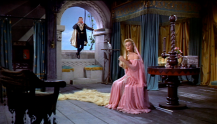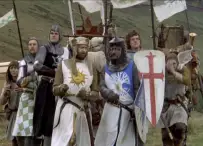Royal Medieval Dress Purple-blue and Black Silver Trim and Belt
Someone suggested to me that for one of my posts I should examine the historical accuracy of costumes from movies set in the medieval era. So, as something fun, that is what I shall do. However, I do not think it is completely fair to critique a film's costumes on historical accuracy alone, for many designers choose to make costumes UN-historically correct for the purpose of the film. Therefore, I shall examine and give two ratings per movie: accuracy (based on clothing actually worn during the era portrayed) and relevancy (based on how well the costumes enhance the purpose and style of the movie).
Ivanhoe (1952): This movie is based on Sir Walter Scott's fictional novel. It is set in the 1190s during the reign of Richard I, more commonly known as Richard the Lionheart, and includes the character of Robin Hood. Overall it is a fun watch, combining medieval legends with historical facts.


Accuracy: 4 stars. Its costumes are actually very accurate. The men characters wear the tunics with looser sleeves and fur-edged mantles commonly worn during the period. The women wear the fashions brought into style by Eleanor of Aquitaine in the latter part of the twelfth century, fashions that were also common a century before. These included vertical tunics with fitted sleeves, girdles worn at the hips, cloaks, and veils worn around the neck and hair and topped with coronets. The colors used are also very accurate, with abundant blues, grays, burgundys, and earth tones. The one fault is that the women's gowns are very tight-fitting, whereas during that time they were much more loose, intending to accentuate the vertical. I also noticed that the crowns and coronets worn by both the men and women were worn incorrectly. They should be worn straight on top of the head so that they cross the forehead, but in the film they wore them tilted so that they centered on the back of the head.
Relevancy: 5 stars. I think for the purpose of this film accurate costumes aided in the portrayal of the story. It gives the entire plot a more genuine feel, taking the mystical and almost fairy-tale aspects out of the medieval legends. However, the small details that are not completely accurate allow the movie to retain the romantic ideal of the Middle Ages portrayed by Sir Walter Scott in his novel.
The Court Jester (1956): This is a very fun comedy set generically in medieval times. It includes singing, plots, a character resembling Robin Hood, wooing, bewitching, and plenty of tongue twisters. Although there is no specific century or year assigned, it is most likely modeled after the late 14th/early 15th century.


Accuracy: 3.5 stars. The costumes in the film are not the most accurate. They stem from a much more romanticized view of medieval times, castles, knights, and princesses. The colors are one aspect that show this view; not only are they much brighter and plentiful than they would be realistically (especially the pink), but they pervade almost every article of clothing. Historically, women's wimples and veils were almost always white or gray. In this movie, however, they usually always matched in color the gowns worn with them. There was also bountiful amounts of bare shoulders and uncovered hair. These things were not uncommon in the 1400s, but off-the-shoulder dresses were made in a different style than those shown in the film. Hair was usually contained in elaborate headdresses (which were surprisingly missing and I think they should have added more of), and if exposed was usually plaited or bound up. The male costumes were actually a lot more accurate; the extravagance of some of the male costumes (especially the jester's) matched the styles of the period. The king also managed to always be clothed in the royal colors of red, purple, and gold, (along with plenty of fur) which may seem stereotypical but was actually very appropriate in the period. Despite some inaccuracies, the general idea of the costumes was more or less correct and there were some details that were surprisingly accurate, including the girdles, coronets with veils, and cloaks lined with fur.
Relevancy: 5 stars. Although the costumes were very much exaggerated, they went together with the style of the film perfectly. The movie was definitely a parody/overplayed/extremely romanticized version of the middle ages, so of course the costumes fed this nicely. I thought the overall effect was very enchanting and did add to the humor and nostalgic feeling emanating from this movie. Also, since the movie is based generally on the middle ages and not a specific time frame from that era, the fact that the costumes were also generic and taken from a few different times added to the atmosphere.
Monty Python and the Holy Grail (1975): This movie is a parody of the middle ages and the legends of King Arthur. The time frame can be assumed to be around 1350, the first time the black plague swept through England and wiped out a substantial amount of the population, because this phenomena is prevalent throughout the film.


Accuracy: 2.5 stars. Despite the fact that almost everything in this movie is over-the-top and completely ridiculous, the costumes are mostly painfully plain and simple, almost devoid of color. This is usually appropriate for the peasants, but the nobles and even upper-class would have worn clothing much more elaborate. It is obvious that the women's costumes especially had little attention paid to them. All of the styles are more similar to styles worn fifty years, even a century prior, especially the long, more shapeless gowns, circular coifs worn with chinstraps and wimples, as well as the straight unadorned tunics worn by the men. The helmets and armor worn by the knights are also of a very simple type that would have been worn around 1200, 150 years before the plague ever hit England.
Relevancy: 5 stars. Even though these costumes are not spot-on accurate per se, the movie is meant to be a farce and a play on modern views of medieval times, not a historical drama whatsoever. They are also not a very important part of the movie, as the point is not to establish the story in a specific time period (there are way to many modern references to make that even a theory) but rather to portray the Arthurian attributes of the story in a lighthearted way. I thought the costumes fit nicely with the tone and point of this film and are an interesting look into the way the modern media or pop culture views the middle ages.
Braveheart (1995): This movie is set during the Scottish rebellions around 1300, during the rule of Edward I "Longshanks." The story is centered on the bravery and leadership of the famous William Wallace, and though well-made with an interesting story, this film is notorious for being historically inaccurate.


Accuracy: 4 stars. Despite this movie's reputation for historical inaccuracy when it comes to events and people, the costumes are for the most part surprisingly correct. It is obvious that the costumes of the nobles were well-researched and well-made, for they usually correspond directly to the fashions brought into style around 1300, including Isabelle's hair cauls, veils, and gowns with both tight and trailing sleeves. The only fault would be that the princess's hip belts and girdles are more similar to those worn half of a century later. However, the peasants costumes are not quite accurate because the belted kilts worn by the main characters were actually not worn until the 1700s. They especially became popular then as Scottish nationalist costumes.
Relevancy: 5 stars. Correctness in costume really enhanced the atmosphere in the film and helped to make the highly fictionalized story more plausible and realistic-looking. I also thought the sharp contrast between the Scottish peasants' clothing and the English nobles' attire spoke volumes into the social conflict between the two groups, which was the basis for the entire story. Even though the peasants' costumes were not completely accurate, they better defined the differences between the Scottish and English and gave off a aura of "Scottish pride."
A Knight's Tale (2001): This movie is set in mid-14th century Europe during the reign of Edward III and contains his son Edward, the Black Prince of Wales, as well as Geoffrey Chaucer. It's a bit of a spoof of the middle ages, containing some aspects that are much more modern, but most of the elements are medieval in both culture and setting.


Accuracy: 2.5 stars. The male costumes are very accurate in this film, including the style of the armor and nobles' clothing. However, the costumes of Jocelyn and her maid are completely different from what medieval women would have worn during that time period. Their gowns obviously have much more of a modern influence, as do their hairstyles. Even the basic styles of their gowns are usually nowhere close to what women wore in 1350 (usually tight-fitting cotehardies with hip-belts, sometimes off-the shoulder, often with loose pelicons or cloaks worn over). Jocelyn's hair is often worn uncovered and styled in ways never seen in medieval times. Medieval women in that period usually wore headdresses with veils and if they left their hair uncovered it was almost always plaited in some form or fashion.
Relevancy: 4 stars. I really adore this movie, but the one thing that has continued to bother me were Jocelyn's costumes. They were so out of place that they became almost an eyesore. There were other modern aspects to the film, yes, including the trumpets producing sounds similar to electric guitars and the nike sign hammered on the armor (both of which I thought were quite clever), but they were much more subtle than her outrageous dress. While her costumes did support the modern aspects of the film, obviously had a lot of thought put into them, and helped her to "stick out," I think it would have benefitted the movie better if they had made her costumes more realistic and dropped the spiky hair and neon feathers (and she still would have stuck out against the backdrop of peasant's clothes almost prevalent throughout the film). Now that I think about it though, she would have fit right in a Star Wars movie…
Read Full Post »
Royal Medieval Dress Purple-blue and Black Silver Trim and Belt
Source: https://historyofeuropeanfashion.wordpress.com/category/medieval-1100-1450/
0 Response to "Royal Medieval Dress Purple-blue and Black Silver Trim and Belt"
Post a Comment